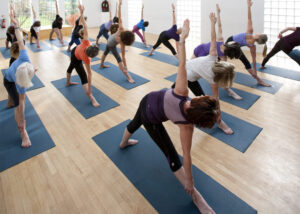When delving deep into the history of yoga, one will find that yoga originated as a spiritual practice. The practice aims to use the mind to create contentment and joy within the individual. Many years later, yoga evolved into four different paths of practice, with each focusing on something else of the human being.
Jnana yoga refers to the spiritual aspect of wisdom pertaining to yoga. Many consider it one of the hardest paths one can choose and it requires plenty of self-discipline. One of the reasons that Jnana yoga is so difficult is that it will require plenty of willpower. However, having intellect will greatly improve the success one can have.
In the following article, we will look slightly deeper at Jnana yoga. Since it is one of the most important forms of yoga, you should understand how it works. We will look at some of the meanings and the way one can practice them. Now, you should be ready to practice Jnana yoga and be on the right track.
Basic Definitions And Meaning Of Jnana Yoga
To define Jnana yoga one can consider the word knowledge. It refers to knowing the being without the objective experience. In Lehman’s terms, it refers to one being more in tune with them, while allowing life to be. Being content with life by disregarding the materialistic is important when practicing Jnana yoga.
One of the things that many misinterpret is the Jnana yoga pronunciation. When speaking of the word, the pronunciation is actually “Gyaan yoga”. Many people also refer to it as “Gyaan Marg”, but both of them mean the “path of knowledge”, with the idea of finding your higher self and becoming more enlightened.
What Is Jnana Yoga?
As mentioned, the meaning of Jnana yoga is knowledge or wisdom. However, the focus of the practice is to attain as much knowledge as possible of the true nature of reality. The way you will achieve this form of higher self-using Jnana yoga is to explore meditation, self-inquiry, and understanding contemplation of life. Here is a small breakdown of the method of Jnana yoga:
Meaning Of Jnana Yoga
When practicing Jnana yoga, one will delve deeper into the mind and understand the nature of the mind. While contemplating life, it becomes important to disassociate from the ego and many of the thoughts of your mind. While performing it, one will eventually start to find a higher meaning and reduce the negativity.
In yoga, the world of Maya refers to the illusion of life. Many people will constantly live in the illusion of life and chase some of these illusions. The downside is that many of these illusions can dictate our actions. For instance, chasing money can lead to breaking internal morals and stepping on other people to be successful.
With Jnana yoga, one can avoid these things by breaking the hold of Maya on your life. Additionally, breaking Maya in your life will influence your thoughts. As a normal individual in society, it is very rare to have complete confidence in life. The practice of this form of yoga will remove the “illusion” of limiting thoughts.
Once you have a better mindset, your thoughts will often follow suit. These thoughts holding you back will also require a lot of energy. Once they are broken, one can redirect the energy to different thoughts. The more positive thoughts you have, the better you will be at achieving your goals and being more content with life.
How To Practice The Yoga of Knowledge
By now, you might have realized that Jnana yoga is one of the hardest forms of yoga to practice. Many people get too hung up on intellectual attainment, but often forget to cultivate humility and compassion. Many people recommend that you practice Bhakti Yoga, Karma Yoga, and Raja Yoga as prerequisites and to learn some of the other basic skills.
Once one has done some of the other forms of yoga, you might want to get a teacher to assist you in practicing Jnana Yoga. It is much better to start with the four pillars of knowledge before diving directly into Jnana yoga. Here are the four key pillars one should consider prerequisites before starting Jnana Yoga.
The Prerequisites Of Jnana Yoga
Much like other forms of yoga, there are a couple of steps that you will need to follow. Many people consider the following four prerequisites as the four pillars of knowledge (Sadhana Chatushtaya). If you aim to achieve liberation, you will need to follow these steps, but one can also use these techniques to cultivate some spiritual insight:
- Viveka (Discrimination, Discernment). Viveka is one of the first steps that one will take when practicing Jnana yoga. The first steps focus on deliberately and continuously taking an intellectual approach to distinguish between the real and the unreal. One of the focuses is to dissociate yourself from the earthly self and to find your spiritual self.
- Vairagya (Detachment, Dispassion). The second prerequisite is to form a detachment to some of the worldly or temporal objects that one might own. However, one of the main goals is to disassociate from the ego and understand that there is a deeper meaning to life than the ego. Once the mind is free from any attachments, accumulating real knowledge will start.
- Mumukshutva (Yearning, Longing). Finally, the final prerequisite is to have a mindset of yearning for liberation. It is referred to as the intense and passionate desire to achieve liberations. However, it will take complete focus and dedication to achieve this state.
- Shatsampat (6 Virtues). Shatsampat is one of the final prerequisites and refers to the 6 main mental practices. These mental practices are designed to stabilize emotions and the mind. It can help one achieve a better logical approach to life. It will help the individual develop the mindset and vision to see beyond Maya illusions.
Here are the 6 virtues Shatsampat refers to:
- Shama (Calmness, Tranquility): Shama is one of the methods that one will use to bring calmness to the mind and reduce the external reaction. It is one of the best ways to help counter and do away with any impulsiveness someone might have.
- Dama (Control, Restraint): Dama is the practice of strengthening the mind to resist temptations. It helps the individual to control the senses and reduces the impulsiveness of reacting to these senses.
- Uparati (Renunciation, Withdrawal): When reaching the third step of Uparati, one will start moving away from things that are not necessary. The goal of the step is to focus on the things that are important and your duty.
- Titiksha (Forbearance, Endurance): The practice of Titiksha is one of the best ways to let life just be. It helps you focus on the things that are within your control and ignore the things that cannot be controlled.
- Shraddha (Trust, Faith): This refers to the belief in one’s teacher and mentor and placing some trust in the individual to help you improve.
- Samadhana (Concentration, Focus): Samadhana is the final step and it is when one has a one-minded approach to direct your energy in the right spots.
When practicing Jnana and you focus on these steps, one must follow them in the designated order. The main purpose is to reach the final goal of one-mindedness, which helps the individual direct all their energy in one specific direction.
The Three Jnana Yoga Core Practices
Once you have mastered the key pillars, you must focus on the core practices. These core practices will focus on hearing, reflection, and meditation. Once you have mastered these three core practices, it will lead to direct realization, which is also referred to as “Atma-Sakshatkara”.
- Sravana (Hearing)
The goal of Sravana is to listen to or experience some of the Ancient Vedic text. During these times, the student should focus on studying the texts of the Upanishads. However, one should consider having a teacher, and since many of these teachings and studies can be complex, the goal of the teacher is to guide the yogi through the process.
- Manana (Reflection)
After you have gone through all the different teachings, the yogi must take a step back for reflection. During this phase, it is expected from the yogi to contemplate and reflect on the many ideals of svadhyaya and Sravana. It can be seen as the time when you become more attached to the information before making it a lifestyle.
- Nididhyasana (Meditation)
Meditation is one of the final steps and once you have done the studying and reflecting, it is time to put this to practice. The main goal is the one should reflect on the meanings of Maha-Vakyas. If the yogi can continuously focus on the seeds of wisdom, they can obtain the union of action and thought, while also creating a union between being and knowing.
Jnana Yoga Poses
Unlike other forms of yoga, Jnana yoga does not have a specific set of asanas or poses that is taught to the person by the teacher. Since the goal of Jnana yoga is to uncover the truth of life the truth of being, it is more of a spiritual approach to yoga. The main goal is to acquire as much knowledge as possible about the teachings.
Once you have acquired and learned some of the teachings, you should apply them to everyday life. The person needs to constantly abide by the lifestyle and teachings of these forms of yoga. Additionally, you will be taught the connections between things in life and have a deeper level of understanding for enduring life.
Once again, we would recommend that before one starts practicing Jnana yoga, you will need to follow the prerequisites. If you can successfully work through some of these prerequisites, it will be slightly easier to practice Jnana and put in the work that is required from a mental aspect.
Wrap-Up
When practicing Jnana yoga, you will find that your mind is opened up to something deeper and more meaningful. One can’t master Jnana yoga and while you become more experienced, you will find that there are a lot of teachings to understand. Let us know in the comment section if you have attempted Jnana yoga.







